Abstract
This paper considers a class of non-homogeneous fractional systems with harmonic terms by means of the Riemann–Liouville definition. Two different approaches are applied to obtain the dual solution of the studied class. The first approach uses the Laplace transform (LT) and the solution is given in terms of the Mittag-Leffler functions. The second approach avoids the LT and expresses the solution in terms of exponential and periodic functions which is analytic in the whole domain. The current methods determine the solution directly and efficiently. The results are applicable for other problems of higher order.
Keywords:
periodic solution; Mittag-Leffler; Riemann–Liouville; fractional calculus; Laplace transform MSC:
34A08
1. Introduction
The fractional calculus (FC) is a natural generalization of the classical calculus (CC). The FC is useful in studying physical phenomena of memory effects [1,2,3]. In [4,5,6,7,8], several models have been solved in view of FC. In addition, other interesting results for the FC applications are listed in [9,10,11,12,13,14]. In elementary physics, some problems have been reformulated and re-solved via the FC. For example, the projectile motion was analyzed in [15,16] via the Caputo fractional derivative (CFD), where the comparisons between their results and experimental data have been declared. The same problem has been solved via the Riemann–Liouville fractional derivative (RLFD) in [17]. Such models were introduced as second-order fractional initial value problems (second-order FIVPs).
For first-order fractional initial value problems (first-order FIVPs), an example has been presented recently in [18,19] in which the model of light absorption by the interstellar matter was solved. The Laplace transform (LT) was successfully applied in [19] to construct the exact solution. The same model has been solved via the RLFD by El-Zahar et al. [20]. However, they applied a series solution method and hence obtained the solution in a closed series form through avoiding the LT. This means that the approximate or the exact solution of a physical model mainly depends on the chosen method of solution [21,22,23,24,25,26,27,28,29,30,31,32,33].
This work aims to apply the RLFD to the following class:
where is the non-integer order of the RLFD, while a, b, , , and A are constants. The class (1) seems simple, however, determining its exact solution is not an easy task as demonstrated later. It will be declared that class (1) has a dual solution. Two types of exact solutions are to be obtained for the current class. The first solution will be determined via Mittag-Leffler functions through the LT. Moreover, the second one avoids such functions, and instead, it uses exponential/trigonometric functions. It will be shown that the dual solution reduces to the corresponding results in [31] when b vanishes. Moreover, our solutions agree with those of ordinary derivatives as . Furthermore, characteristics of the dual solution will also be analyzed. The solution involving exponential/trigonometric functions has some advantages over the Mittag-Leffler one which will be demonstrated later.
The paper is organized as follows. In Section 2, some preliminaries and concepts in fractional calculus are presented. Section 3 is devoted to analyze the complementary and particular solutions of the governing equation. In addition, some theoretical results are obtained in this section. Moreover, Section 4 focuses on deriving the dual solution of the current system. The behavior and the properties of the obtained solution are discussed in Section 5. The paper is concluded in Section 6.
2. Preliminaries
The RLFD of order of function is (see [1,2,3])
where is the integral part of . As and for , we have [30,31]
In [1,2,3], the LT of the RLFD (as ) is given by
So, our paper considers the two RLFD operators and . The first operator is defined from (as the initial point c) which will be used to construct the solution in terms of exponential and periodic functions with the help of the properties in Equation (3). The second operator is defined from and it allows to use the LT in Equation (4) and hence to obtain the solution via the Mittag-Leffler function.
The inverse LT of the following expression is expressed in terms of the Mittag-Leffler function as
where the Mittag-Leffler function of two parameters is defined as
The definition (6) leads to
The following expressions can be derived as special cases of Formula (5)
3. Analysis
Theorem 1.
The complementary solution is
where is a constant.
Proof.
The complementary solution is the solution of the homogeneous part of Equation (1):
In view of [31], the solution takes the form:
where is a constant. The can be determined by substituting (13) into (12), this yields
The constant will be determined later by applying the given initial condition. □
Theorem 2.
Proof.
The coefficients and can be obtained by solving the following coupled algebraic equations:
and then,
Inserting (22) into in (17) and simplifying, we obtain
This solution reduces to the corresponding one in [31] when . It is also agrees with that reported in [30] at and . □
Corollary 1.
The solution of the fractional differential equation (FDE):
is
Proof.
This result coincides with that reported in [30]. □
Corollary 2.
The FDE:
has the following solution :
4. The Dual Solution
In this section, it is shown that a dual solution exists for the class (1).
4.1. First Solution: Mittag-Leffler Functions
The inversion reads
or
and thus,
i.e.,
or
The case gives
hence,
Therefore,
4.2. Second Solution: Exponential/Trigonometric Functions
Based on the results of Section 3, the general solution of Equation (1) is
where and were already obtained by Theorem 2. We have from Equation (40) that
At , we have
i.e.,
Utilizing the condition , we have
Therefore,
Inserting in terms of gives
Thus,
where and are given by Equations (18). Consider , then
where
Substituting (49) into (48), we get
This equation coincides with Equation (39). In addition, Equation (47) becomes the same result as that reported in [30] at . Although Equation (47) is analytic , it is real at certain values of , see [31].
Remark 1.
One of the main advantages of this work is that it generalizes the existing results in the literature [30,31] by addressing the additional sinusoidal term . In addition, the current analysis introduces a simple and a straightforward approach in contrast to the operator method [30] that was used to derive the solution at the special case of the present class. Moreover, the obtained dual solution in [31] can be recovered as a special case of our results. Furthermore, the current simple approach seems effective to determine the exact solution of a generalized class involving any finite number of sinusoidal terms. For example, the present analysis can be used to solve the following class with harmonic terms:
Therefore, the exact solution of this generalized class can be directly derived as a consequence of the current simple/effective approach if compared with the previous results in the literature [30,31].
5. Properties of Solutions
The solution (47) is real when , i.e., if . Very recently, Ebaid and Al-Jeaid [31] proved the following theorem to specify those values of at which .
Theorem 3
([31]). For , when () and ().
According to this theorem, the solution (47) is displayed in Figure 1, Figure 2, Figure 3 and Figure 4 at some selected values of . At such values, the periodicity/oscillatory of the solution appear in these figures. Moreover, as , the present fractional solution is identical to the ordinary one given by Equation (50), as can be observed in Figure 4. In addition, the impacts of A and on the behavior of are shown in Figure 5 and Figure 6.
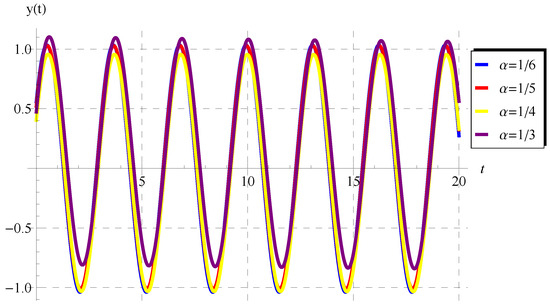
Figure 1.
Graphs of the solution (47) at , , , , and for .
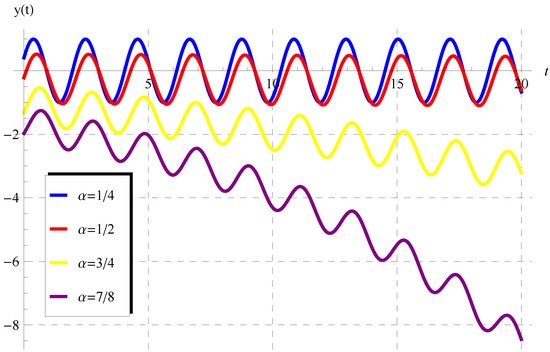
Figure 2.
Graphs of the solution (47) at , , , , and for .
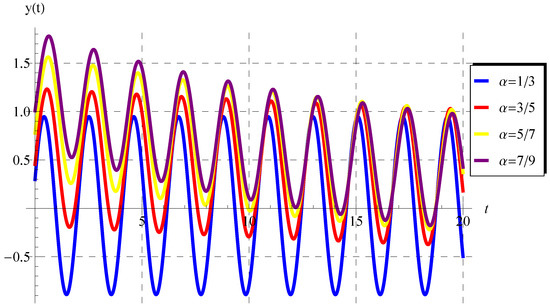
Figure 3.
Graphs of the solution (47) at , , , , and for .

Figure 4.
Graphs of the solution (47) at , , , , and for .
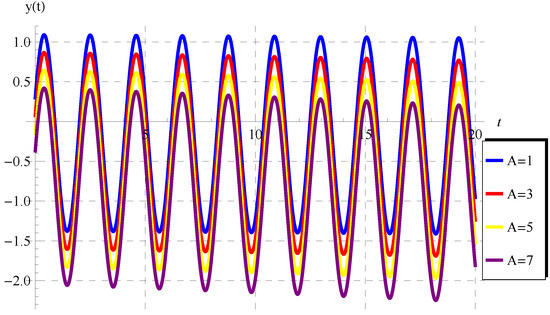
Figure 5.
Graphs of the solution (47) at , , , , and for .
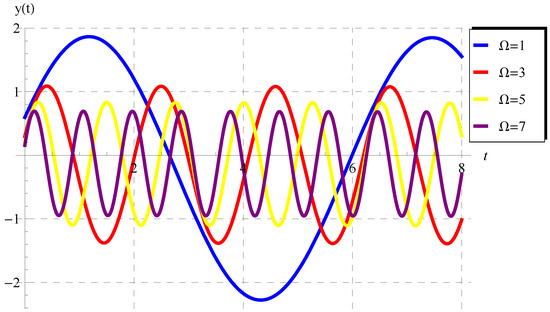
Figure 6.
Graphs of the solution (47) at , , , , and for .
6. Conclusions
In this paper, a class of oscillatory problems in engineering was analyzed. A dual solution for such a class was obtained. The LT method was applied to obtain the solution with the help of Mittag-Leffler functions, but this solution was not analytic at the initial time. In order to obtain an analytic solution in whole domain, a new approach was developed which gave the solution in terms of exponential/trigonometric functions. The latter solution was analytic everywhere and real at prescribed values for . Such values of that admit real solutions were theoretically verified through several plots. The developed approach can be extended to solve other higher-order oscillatory problems in the FC, including more generalized fractional operators [32,33,34,35].
Author Contributions
Conceptualization, A.F.A., A.E. and H.K.A.-J.; methodology, R.S.E.A., A.F.A., A.E. and H.K.A.-J.; software, A.E.; validation, R.S.E.A., A.F.A., A.E. and H.K.A.-J.; formal analysis, R.S.E.A., A.F.A., A.E. and H.K.A.-J.; investigation, R.S.E.A., A.F.A., A.E. and H.K.A.-J.; data curation, A.E.; writing—original draft preparation, R.S.E.A.; writing—review and editing, R.S.E.A., A.F.A., A.E. and H.K.A.-J.; visualization, A.E. All authors have read and agreed to the published version of the manuscript.
Funding
This research received no external funding.
Data Availability Statement
Not applicable.
Conflicts of Interest
The authors declare no conflict of interest.
References
- Miller, K.S.; Ross, B. An Introduction to the Fractional Calculus and Fractional Differential Equations; John Wiley & Sons: New York, NY, USA, 1993. [Google Scholar]
- Podlubny, I. Fractional Differential Equations; Academic Press: San Diego, CA, USA, 1999. [Google Scholar]
- Hilfer, R. Applications of Fractional Calculus in Physics; World Scientific Publishing Company: Singapore, 2000. [Google Scholar]
- Narahari Achar, B.N.; Hanneken, J.W.; Enck, T.; Clarke, T. Dynamics of the fractional oscillator. Physica A 2001, 297, 361–367. [Google Scholar] [CrossRef]
- Sebaa, N.; Fellah, Z.E.A.; Lauriks, W.; Depollier, C. Application of fractional calculus to ultrasonic wave propagation in human cancellous bone. Signal Process. 2006, 86, 2668–2677. [Google Scholar] [CrossRef]
- Tarasov, V.E. Fractional Heisenberg equation. Phys. Lett. A 2008, 372, 2984–2988. [Google Scholar] [CrossRef]
- Ding, Y.; Yea, H. A fractional-order differential equation model of HIV infection of CD4+T-cells. Math. Comput. Model. 2009, 50, 386–392. [Google Scholar] [CrossRef]
- Wang, S.; Xu, M.; Li, X. Green’s function of time fractional diffusion equation and its applications in fractional quantum mechanics. Nonlinear Anal. Real World Appl. 2009, 10, 1081–1086. [Google Scholar] [CrossRef]
- Song, L.; Xu, S.; Yang, J. Dynamical models of happiness with fractional order. Commun. Nonlinear Sci. Numer. Simul. 2010, 15, 616–628. [Google Scholar] [CrossRef]
- Gómez-Aguilara, J.F.; Rosales-García, J.J.; Bernal-Alvarado, J.J. Fractional mechanical oscillators. Rev. Mex. Física 2012, 58, 348–352. [Google Scholar]
- Machado, J.T.; Kiryakova, V.; Mainardi, F. Recent history of fractional calculus. Commun. Nonlinear Sci. Numer. Simul. 2011, 16, 1140–1153. [Google Scholar] [CrossRef]
- Ebaid, A.; El-Sayed, D.M.M.; Aljoufi, M.D. Fractional calculus model for damped mathieu equation: Approximate analytical solution. Appl. Math. Sci. 2012, 6, 4075–4080. [Google Scholar]
- Garcia, J.R.; Calderon, M.G.; Ortiz, J.M.; Baleanu, D. Motion of a particle in a resisting medium using fractional calculus approach. Proc. Rom. Acad. Ser. A 2013, 14, 42–47. [Google Scholar]
- Machado, J.T. A fractional approach to the Fermi-Pasta-Ulam problem. Eur. Phys. J. Spec. Top. 2013, 222, 1795–1803. [Google Scholar] [CrossRef]
- Ebaid, A. Analysis of projectile motion in view of the fractional calculus. Appl. Math. Model. 2011, 35, 1231–1239. [Google Scholar] [CrossRef]
- Ebaid, A.; El-Zahar, E.R.; Aljohani, A.F.; Salah, B.; Krid, M.; Machado, J.T. Analysis of the two-dimensional fractional projectile motion in view of the experimental data. Nonlinear Dyn. 2019, 97, 1711–1720. [Google Scholar] [CrossRef]
- Ahmad, B.; Batarfi, H.; Nieto, J.J.; Otero-Zarraquiños, Ó.; Shammakh, W. Projectile motion via Riemann-Liouville calculus. Adv. Differ. Equ. 2015, 2015, 63. [Google Scholar] [CrossRef]
- Kumar, D.; Singh, J.; Baleanu, D.; Rathore, S. Analysis of a fractional model of the Ambartsumian equation. Eur. Phys. J. Plus 2018, 133, 133–259. [Google Scholar] [CrossRef]
- Ebaid, A.; Cattani, C.; Al Juhani, A.S.; El-Zahar, E.R. A novel exact solution for the fractional Ambartsumian equation. Adv. Differ. Equ. 2021, 2021, 88. [Google Scholar] [CrossRef]
- El-Zahar, E.R.; Alotaibi, A.M.; Ebaid, A.; Aljohani, A.F.; Aguilar, J.G. The Riemann-Liouville fractional derivative for Ambartsumian equation. Results Phys. 2020, 19, 103551. [Google Scholar] [CrossRef]
- Kaur, D.; Agarwal, P.; Rakshit, M.; Chand, M. Fractional Calculus involving (p,q)-Mathieu Type Series. Appl. Math. Nonlinear Sci. 2020, 5, 15–34. [Google Scholar] [CrossRef]
- Agarwal, P.; Mondal, S.R.; Nisar, K.S. On fractional integration of generalized struve functions of first kind. Thai J. Math. 2020; to appear. [Google Scholar]
- Agarwal, P.; Singh, R. Modelling of transmission dynamics of Nipah virus (Niv): A fractional order approach. Phys. A Stat. Mech. Appl. 2020, 547, 124243. [Google Scholar] [CrossRef]
- Alderremy, A.A.; Saad, K.M.; Agarwal, P.; Aly, S.; Jain, S. Certain new models of the multi space-fractional Gardner equation. Phys. A Stat. Mech. Appl. 2020, 545, 123806. [Google Scholar] [CrossRef]
- Feng, Y.Y.; Yang, X.J.; Liu, J.G.; Chen, Z.Q. New perspective aimed at local fractional order memristor model on Cantor sets. Fractals 2020, 29, 2150011. [Google Scholar] [CrossRef]
- Feng, Y.Y.; Yang, X.J.; Liu, J.G. On overall behavior of Maxwell mechanical model by the combined Caputo fractional derivative. Chin. J. Phys. 2020, 66, 269–276. [Google Scholar] [CrossRef]
- Sweilam, N.H.; Al-Mekhlafi, S.M.; Assiri, T.; Atangana, A. Optimal control for cancer treatment mathematical model using Atangana-Baleanu-Caputo fractional derivative. Adv. Differ. Equ. 2020, 2020, 334. [Google Scholar] [CrossRef]
- Atangana, A.; Qureshi, S. Mathematical Modeling of an Autonomous Nonlinear Dynamical System for Malaria Transmission Using Caputo Derivative. Fract. Order Anal. Theory Methods Appl. 2020, 225–252. [Google Scholar] [CrossRef]
- Elzahar, E.R.; Gaber, A.A.; Aljohani, A.F.; Machado, J.T.; Ebaid, A. Generalized Newtonian fractional model for the vertical motion of a particle. Appl. Math. Model. 2020, 88, 652–660. [Google Scholar] [CrossRef]
- El-Dib, Y.O.; Elgazery, N.S. Effect of Fractional Derivative Properties on the Periodic Solution of the Nonlinear Oscillations. Fractals 2020, 28, 2050095. [Google Scholar] [CrossRef]
- Ebaid, A.; Al-Jeaid, H.K. The Mittag–Leffler Functions for a Class of First-Order Fractional Initial Value Problems: Dual Solution via Riemann–Liouville Fractional Derivative. Fractal Fract. 2022, 6, 85. [Google Scholar] [CrossRef]
- Qiao, L.; Xu, D.; Qiu, W. The formally second-order BDF ADI difference/compact difference scheme for the nonlocal evolution problem in three-dimensional space. Appl. Numer. Math. 2022, 172, 359–381. [Google Scholar] [CrossRef]
- Zhang, T.; Li, Y. Exponential Euler scheme of multi-delay Caputo–Fabrizio fractional-order differential equations. Appl. Math. Lett. 2022, 124, 107709. [Google Scholar] [CrossRef]
- Atangana, A.; Baleanu, D. New fractional derivatives with non-local and non-singular kernel: Theory and applications to heat transfer model. Therm. Sci. 2016, 20, 763–769. [Google Scholar] [CrossRef]
- Lotfi, E.M.; Zine, H.; Torres, D.F.M.; Yousfi, N. The Power Fractional Calculus: First Definitions and Properties with Applications to Power Fractional Differential Equations. Mathematics 2022, 10, 3594. [Google Scholar] [CrossRef]
Publisher’s Note: MDPI stays neutral with regard to jurisdictional claims in published maps and institutional affiliations. |
© 2022 by the authors. Licensee MDPI, Basel, Switzerland. This article is an open access article distributed under the terms and conditions of the Creative Commons Attribution (CC BY) license (https://creativecommons.org/licenses/by/4.0/).